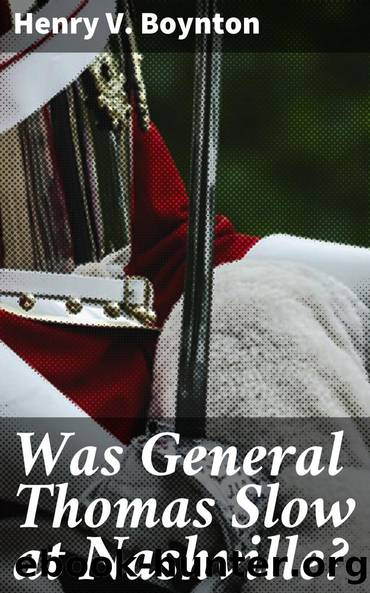Was General Thomas Slow at Nashville? by Henry V. Boynton

Author:Henry V. Boynton [Boynton, Henry V.]
Language: eng
Format: epub
Tags: Fiction, Classics
ISBN: 9785040617920
Google: 3M5SEAAAQBAJ
Publisher: Litres
Published: 2021-12-02T00:56:27+00:00
THE CAVALRY AFTER NASHVILLE.
Table of Contents
Six divisions of the cavalry corps were put in camp, extending for twelve miles along the north bank of the Tennessee from Gravelly Springs to Waterloo Landing. A winter campaign was laid out at army headquarters for Thomasâs army, to begin without rest or refittingâthe resting to be done by proxy in the vicinity of City Point. But owing to rains and unusual floods this plan for Thomas could not be pursued, and the time was improved for a vigorous and rapid refitting of his forces.
Early in March a cavalry corps of 27,000 had been gathered. The men were veterans. The new equipment collected was excellent, but, with all that the Cavalry Bureau could do, only 17,000 horses could be provided. This force was raised, by drills and every form of perfecting an organization, to a high state of efficiency. While vigorous efforts were in progress to equip Hatchâs veteran division of 10,000, the orders from Washington and City Point for forward movement began to pour in on Thomas. While no other national army was moving, the nine weeks of midwinter which Thomas was using in most active measures for beginning a crushing campaign were begrudged him, and he was again prodded to move before he was ready. Next, the breaking up of the cavalry force which had been assembled and prepared with such great labor began. One division, 5000 strong, was ordered off to Canby at Mobile, where its operations proved of little consequence, and Thomas was ordered with 5000 more to make a demonstration on Tuscaloosa and Selma.
General Wilson then urged with great ability and power that the cavalry should go as a body, with the purpose of destroying the various factories of war material and breaking the interior lines of communication and supply. Grant, who had great confidence in Wilson from his long service on his staff, consented, and the plan, warmly approved by Thomas, was adopted, and Wilson was started with all the powers of an independent commander.
On the 22d of March Wilson had crossed the Tennessee and started toward Selma. He had three divisions, Uptonâs, Longâs, and E. M. McCookâs. The aggregate strength was 12,500 mounted, and 1500 dismounted to follow till they could be furnished with captured horses. It was in every sense a command thoroughly equipped and fully supplied. The divisions marched on different roads, but the objective of each was Selma. The direct distance was 180 miles, and the average march of each division to reach it was 250 miles. The streams were still flooded in all directions, and the roads deep and difficult. The vigor and skill with which all these obstacles were overcome form a brilliant chapter, not exceeded in kind during the war.
At Montevallo, forty-five miles from Selma, a portion of Forrestâs command was encountered, and, after a dashing fight, forced to retreat. The Southern leader had not been able, as yet, to concentrate his command. The capture of a courier with dispatches to
Download
This site does not store any files on its server. We only index and link to content provided by other sites. Please contact the content providers to delete copyright contents if any and email us, we'll remove relevant links or contents immediately.
| Africa | Americas |
| Arctic & Antarctica | Asia |
| Australia & Oceania | Europe |
| Middle East | Russia |
| United States | World |
| Ancient Civilizations | Military |
| Historical Study & Educational Resources |
Never by Ken Follett(2865)
The Man Who Died Twice by Richard Osman(2287)
Machine Learning at Scale with H2O by Gregory Keys | David Whiting(2252)
Fairy Tale by Stephen King(2056)
Will by Will Smith(2023)
Rationality by Steven Pinker(1757)
The Dawn of Everything: A New History of Humanity by David Graeber & David Wengrow(1561)
The Dark Hours by Michael Connelly(1557)
Principles for Dealing With the Changing World Order: Why Nations Succeed and Fail by Ray Dalio(1367)
Friends, Lovers, and the Big Terrible Thing by Matthew Perry(1315)
A Short History of War by Jeremy Black(1294)
HBR's 10 Must Reads 2022 by Harvard Business Review(1250)
Go Tell the Bees That I Am Gone by Diana Gabaldon(1231)
Can't Hurt Me: Master Your Mind and Defy the Odds - Clean Edition by David Goggins(1215)
515945210 by Unknown(1205)
Fear No Evil by James Patterson(1101)
443319537 by Unknown(1068)
Works by Richard Wright(1016)
The 1619 Project by Unknown(985)
